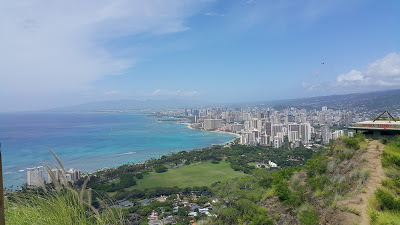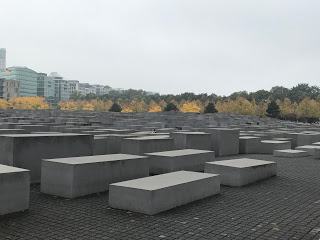or: Bringing the Past to the Present for a Better Future
It’s been an interesting few days in Berlin. It’s a city of contrasts, that’s for sure. According to those that live here, this is the most sunshine they’ve had all year so I decided to make the most of it and walked to many of the areas I wanted to see. Averaging 15,000 steps per day was beneficial given the way I ate.
Many places have had horrendous things happen in and around them over the course of their existence. Berlin is the first one I’ve seen that acknowledges it and the role its played on the world stage so diligently.
 |
| Marker indicating where the Berlin Wall once stood |
From WWII and the sending of Jews (then others) to concentration camps to the Cold War and the construction of the Berlin Wall, both the instigators, the victims and survivors have their stories told around the city through monuments, museums, and educational boards surrounding the relics of either the Wall or the destruction caused during WWII.
The city is continuing to add to the displays, particularly now for the Wall, and explaining what it was like on both sides of it.
 |
| Berlin Wall display. Yes, that’s chewing gum stuck |
There are unbelievable stories of escapes and courageousness over both periods of history. Stories of people running factories and employing blind Jews, the same owner bribing the SS when they are taken away, visiting them in the camps and smuggling in food. Afterward this war, the same man opened an orphanage for those Jews who had lost their families. He did this with the money that was donated to him for his bravery.
Other stories of people smuggling East Berliners through checkpoints in the boot of their car, or dressed up as soldiers. Anyone caught crossing the Wall was shot, no questions asked, by the Stasi (the police of East Berlin).
There is only one statue from the Nazi era remaining in public because it has no symbols on it. The rest and various other pieces are now housed in the Museum of Forbidden Art. Propaganda is removed to a place where it is still accessible without contributing to ongoing offence.
Some of the buildings are repaired and some, like the Italian Embassy, are left with the bullet holes, as a reminder from WWII, For the Cold War, some buildings have also been refurbished and it has caused rents to dramatically increase. Many of these places didn’t have toilets in each apartment so this has changed. Unfortunately wages haven’t increased quite so much so it is pushing people that have lived in areas for a long time to then move.
 |
| Checkpoint Charlie – the other side has the Welcome sign People entering / leaving the East needed to go through a checkpoint |
To walk down the street where the Olympic Torch was carried in 1936, crowds screaming, Hitler not yet widely recognised for what he was capable of doing), to this same street, a few years later being the showcase for the mite of the Nazis as they paraded along, filling the 12 kilometre stretch with those in uniform, tanks and guns.
Stories of the Olympics were interesting. Jesse Owens was liked in Germany (there’s a street named after him now) and the public were wild for him and his achievements. He was apparently treated the same as the other athletes. Returning to America for a victory parade, he needed to use the service entrance due to his skin colour. Stories like this throughout my stay have been enlightening.
There remains a 1.3 kilometre stretch of the Wall which remains unbroken. It has been turned into the East Side Gallery. In 1990, over 109 artists from 21 countries were invited to paint on the East Side of it as previously, no-one on that side was allowed close enough to paint anything. The West Side was different.
 |
| The Kiss – one of the most photographed parts of the Wall |
Ten years later, the original artists were invited back to touch up their work as some had faded, some had graffiti. Unfortunately some of the artists had died over this period and their section of the wall now stands blank, aside from the graffiti. Again this part of the Wall is currently going through a clean up as people have graffitied over parts of it. It’s a bit easier now as the last time the artwork was repainted, another layer of anti-graffiti treatment was added so additional paint, pens etc can be more easily removed.
 |
| Holocaust Memorial – three times the height of me in parts |
By far the most impactful commemoration piece for me was the Holocaust Memorial. It is a tribute to Europe’s victims of the Holocaust. These 2,711 slabs are all the same base measurement, yet are of varying heights going toward the centre. They cover a piece of land the size of a soccer field. They are in neat black rows over the undulating ground. It is quite disorientating being in the middle and looking up, down and sideways. People are quiet as they walk through this area. Thoughts drifted into my head and out again. I felt both heartbroken and distressed that people could do this kind of thing to each other and similar things still happen. I went back a few times as it is open 24 hours.
Berlin has an impressive street art scene too which provides a contrast to all of the above. The scene has moved over the years as each area the artists move to is gradually gentrified. It’s resulted in a few art collectives forming in old railway stations and abandoned blocks. They set up as charities and sometimes, rather ironically, illicit sponsorship from companies even though they are anti-capitalist themselves.
Berlin and Germany itself is still trying to right past wrongs through various means (including providing a free concert this weekend to mark the Wall coming down). Is it perfect? No, but they do seem to be making as much effort as possible. People who can prove their Jewish ancestors escaped Nazi Germany are automatically eligible for a German passport (currently rated the number one passport to have), properties are returned etc. In the former East Berlin, work is ongoing to improve the quality of housing, increase wages and improve industry. It is difficult for various reasons least of which is the city is 60bn euros in debt and has no traditional industry left with the finance sector being based in Frankfurt and the factories are more spread out.
 |
| Yet to be cleaned portion – Gorby driving through the Wall |
There is a real sense of trying to learn from their history. The art work talks of it and even reminds people that freedom is new, remember what it was like to not have it and don’t let this happen again.
I am impressed at the resilience of people.
All of this then has been wondering about the wars and injustices that are going on today and even in the recent history. What are we doing for those people, in those countries and what is actually effective for both the survivors, their families and those that inflicted the wrongs in the first place? Why don’t we learn from history? Isn’t this why we’re told we have to study it at school?
I leave here with more questions than answers.
And slightly worn out sneakers.
* Thanks to New Order for the title to this post.
Note – Berlin is a very lively city too, there is a very active night life and something for everyone. I’ve spoken to quite a few people who have relocated here, intending to stay for a few months and have ended up staying for ten or more years. A bit like me in HK!



